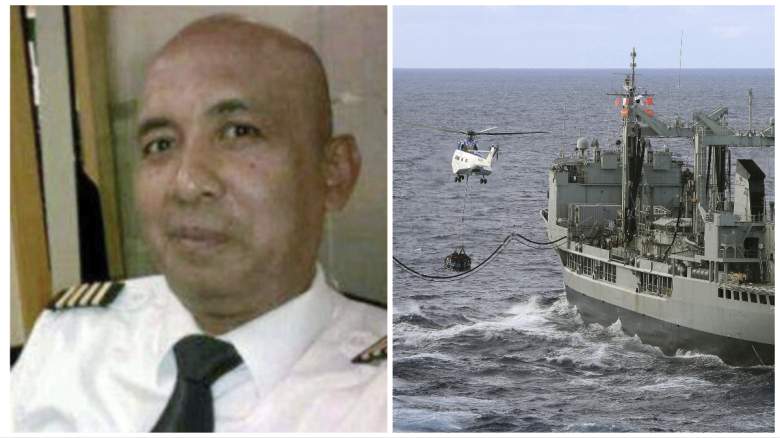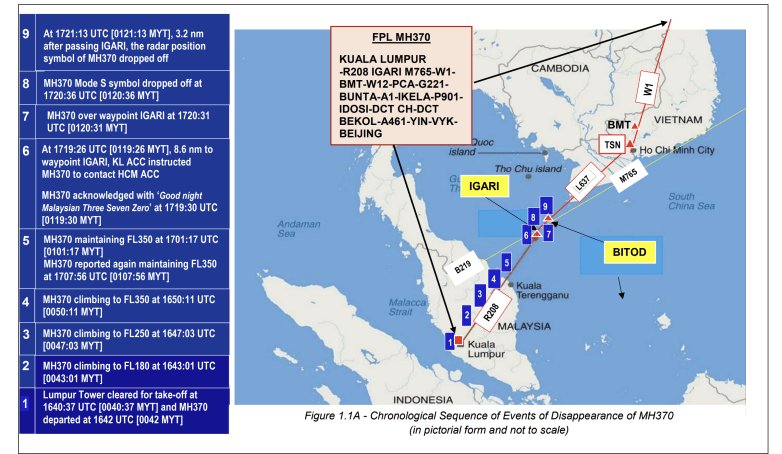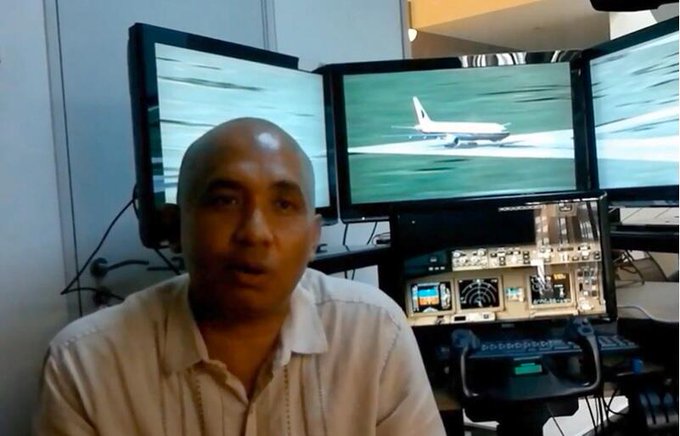
Facebook (Puterawaja Tigers) Zaharie Ahmad Shah and the scene of the search.
Zaharie Ahmad Shah was the captain and lead pilot for MH370, the airplane that disappeared without a trace on March 8, 2014, after taking off from Kuala Lumpur.
A new Netflix series on the fate of MH370, “MH370: The Plane That Disappeared,” is renewing interest in the real story of the pilot, who has long been a key suspect in theories about what happened to the plane.
See the safety investigation report into the plane’s disappearance here. It was written by The Malaysian ICAO Annex 13 Safety Investigation Team for MH370. It found no serious issues in the pilot’s life, but some family members told Daily Mail that he was suffering marital problems, and his at-home flight simulator has been a point of contention.
According to the report, the scheduled passenger flight from Kuala Lumpur to Beijing, operated by Malaysia Airlines (MAS) and designated flight MH370, “went missing soon after a routine handover from the Malaysian Air Traffic Control (ATC) to Viet Nam ATC.”
Here’s what you need to know:
The Report Says 227 Passengers & 12 Crew members Were On Board MH370 When the Plane Vanished, With the Final Communication From Zaharie Ahmad Shah Being, ‘Good Night Malaysian Three Seven Zero’

Investigative ReportThe plane’s route.
The report says that the aircraft “was a Boeing 777-200 ER, registered as 9M-MRO. On board the aircraft were 12 crew and 227 passengers (239 persons in total).”
A review of “available radar and satellite communications indicated that the aircraft flew back across the Malaysian Peninsula and subsequently traveled to the southern Indian Ocean,” the report says.
“Despite an extensive air and sea search, the location of the aircraft and occupants remains unknown. However, some debris have been recovered consistent with having drifted over nearly two years from the area in which impact is thought to have occurred,” according to the report.
According to the report, Lumpur Tower cleared MH370 for take-off just after 4:40 p.m. The plane was cleared to climb to 18,000 feet. The plane was cleared to climb higher; MH370 communicated with air traffic controllers about maintaining flight levels at 5:07 p.m., the report says.
“At 1719:30 UTC [0119:30 MYT], MH370 acknowledged with ‘Good night Malaysian Three Seven Zero.’ This was the last recorded radio transmission from MH370,” the report says.
The radar position suddenly disappeared, according to the report. Military radar showed the plane turning right and then making a constant left turn, it says.
It was also noted that, in the absence of autopilot or continuous manual control, “an aircraft is very unlikely to maintain straight and level flight. Further, it is extremely unlikely for an aircraft to enter and maintain a turn and then return to straight and level flight for any significant period of time,” the report says, adding that the flight diverted from its planned flight route.
“The analysis showed the aircraft changed course shortly after it passed the northern tip of Sumatra (Indonesia) and traveled in a southerly direction until it ran out of fuel in the southern Indian Ocean west of Australia,” the report says.
The Pilot’s Sister Has Defended Him, Saying He Was Turned Into a ‘Scapegoat’
According to CNN, years after the plane disappeared, Shah’s sister, Sakinah Shah, told CNN that she still “thinks of him the first thing in the morning and cries for him the last thing at night.”
She told CNN that he has become a “scapegoat.” She told CNN, “He’s been made a scapegoat from the beginning.”
To CNN, she described the pilot as “very loving, wonderfully considerate and generous. A very, very generous younger brother – in fact most generous one of our family.”
She noted to the network: “He was a young boy, 14 or 15, when he fell in love with airplanes.”
According to the report, the search for Malaysia Airlines flight MH370 “commenced on 8 March 2014 and continued for 1,046 days until 17 January 2017 when it was suspended in accordance with a decision made by the Governments of Malaysia, Australia and the People’s Republic of China.”
This search involved “surface searches in the South China Sea, Straits of Malacca and the southern Indian Ocean,” the report says. “The 52 days of the surface search involving aircraft and surface vessels covered an area of several million square kilometres. A sub surface search for the aircraft’s underwater locator beacons was also conducted during the surface search.”
The report says that the underwater search “started with a bathymetry survey which mapped a total of 710,000 square kilometres of Indian Ocean seafloor and continued with a high-resolution sonar search which covered an area in excess of 120,000 square kilometres. The last search vessel left the underwater search area on 17 January 2017 without locating the missing aircraft.”
According to the report, “Several pieces of debris were found washed ashore the south eastern coasts of Africa (South Africa, Mozambique and Tanzania), the Islands of Madagascar, Mauritius and Réunion, suggesting that the aircraft had suffered damage.”
However, the report continues, “other damages could not be established as the main wreckage of the aircraft had not been found. There was no reported ground impact or damage to any ground facilities or properties.”
The website MH370Search.com reads, “New clues reveal the demise of MH370. Since the crash of MH370 in the Indian Ocean a considerable amount of physical evidence has been gathered. 36 pieces of floating debris have been found and delivered to the Malaysian authorities for investigation.”
Zaharie Ahmad Shah Was Born in the Island of Penang & Was Accepted as a Cadet Pilot in 1981
Shah was referred to in the report as the “Pilot-in-Command” or the “PIC.”
“The PIC was born in the Island of Penang. He completed his Malaysian Certificate of Education (MCE) – the equivalent of the United Kingdom Ordinary (UK ‘O’) Level – at the Penang Free School, where he sat for his MCE Examination in 1978,” the report says.
“In 1981 he was accepted as a Cadet Pilot with MAS under the sponsorship of Majlis Amanah Rakyat (MARA), a People’s Trust Council of the Malaysian Government,” it says.
“The PIC was sent to Manila in the Philippines to be provided ab-initio pilot training and graduated 2 years later with a Commercial Pilot Licence & Instrument Rating (CPL & IR).”
The report continues to describe Shah’s experience:
He joined MAS as a Second Officer in 1983 and was posted on the F27 where he obtained his initial airline flying experience. He was then posted to the B737-200 in 1985, thereafter the A300B4, and stayed on as First Officer (FO) until March 1990. In July 1990 SAFETY INVESTIGATION REPORT MH370 (9M-MRO) 27 he was promoted to captain and took his first command on the F50 aircraft.
By the end of 1991 he was promoted to Captain on the B737-400 until December 1996. His next promotion was to the A330-300 and stayed on the fleet until September 1998 when he was promoted to the B777- 200ER fleet until the day of the event. By virtue of his good track record and seniority he was made a Type Rating Instructor (TRI) and Type Rating Examiner (TRE) on this present fleet effective November 2007.
The PIC’s flying record for the last 72 hours and preceding 28 days’ cycle were well within the Company’s specified limits. His last flight as an operating PIC was to Denpasar, Bali, in the Republic of Indonesia on 03 March 2014. This was a daily return flight with a sector time of approximately 3 hours. On the day of the event, he was conducting training for the FO who was functionally checked out.
4. Zaharie Ahmad Shah Used a Flight Simulator at Home, But It Didn’t Contain Flight Paths Similar to MH370, the Report Says; There Is Conflicting Evidence on This Point
According to the report, Royal Malaysian police seized a home flight simulator from Shah’s residence on March 15, 2014.
“The RMP Forensic Report dated 19 May 2014 documented more than 2,700 coordinates retrieved from separate file fragments and most of them are default game coordinates,” it says.
“It was also discovered that there were seven ‘manually programmed’ waypoint4 coordinates . . . that when connected together, will create a flight path from KLIA to an area south of the Indian Ocean through the Andaman Sea,” the report says.
“These coordinates were stored in the Volume Shadow Information (VSI) file dated 03 February 2014. The function of this file was to save information when a computer is left idle for more than 15 minutes. Hence, the RMP Forensic Report could not determine if the waypoints came from one or more files,” it reads.
“The RMP Forensic Report on the simulator also did not find any data that showed the aircraft was performing climb, attitude or heading manoeuvres, nor did they find any data that showed a similar route flown by MH370. The RMP Forensic Report concluded that there were no unusual activities other than game-related flight simulations,” it reads.
However, The Intelligencer reported that it had obtained a confidential document “from the Malaysian police investigation into the disappearance of Malaysia Airlines Flight 370 that shows that the plane’s captain, Zaharie Ahmad Shah, conducted a simulated flight deep into the remote southern Indian Ocean less than a month before the plane vanished under uncannily similar circumstances.”
According to that report, “the revelation, which Malaysia withheld from a lengthy public report on the investigation, is the strongest evidence yet that Zaharie made off with the plane in a premeditated act of mass murder-suicide.”
The Intelligencer reported:
The document presents the findings of the Malaysian police’s investigation into Zaharie. It reveals that after the plane disappeared in March of 2014, Malaysia turned over to the FBI hard drives that Zaharie used to record sessions on an elaborate home-built flight simulator. The FBI was able to recover six deleted data points that had been stored by the Microsoft Flight Simulator X program in the weeks before MH370 disappeared.
Shah’s sister told CNN the family believes the flight simulator had not been used for a year before the plane vanished. “They did their tests in 2014, there was nothing incriminating in his activities,” she said to CNN.
“The FBI did their tests … if there was anything, the police would be the first people to know. That’s why this story has been dismissed,” she told CNN. According to CNN, Australian authorities insisted that “data from the simulator doesn’t reveal anything about what happened aboard MH370.”
Zaharie Ahmad Shah Had No Major Disciplinary Problems, No Unusual Financial Issues & No Behavioral Problems or Mental Health Issues, the Report Says, But His Wife & Daughter Said He Was Upset About Problems in His Marriage
The wife and daughter of Captain Zaharie Ahmad Shah said he was “distracted and withdrawn in the weeks before the aircraft’s disappearance – and refused pleas to attend some marriage counseling sessions,” Daily Mail reported.
Daily Mail reported that Faizah Khanum Mustafa Khan, the pilot’s wife, “has told investigators that he stopped speaking to her in the weeks before the fateful flight on March 8, and spent time alone in his room where he had built a flight simulator.”
“He just retreated into a shell,” she said, according to Daily Mail.
“I found him distant and difficult to understand,” his wife said, according to Daily Mail.
According to Daily Mail, Shah “was a fervent supporter of Anwar, a pro-democracy icon in Malaysia who was jailed for five years for sodomy hours before Flight MH370 took off for the final time.”
According to Daily Mail, “Anwar’s supporters believe it was a politically motivated prosecution.”
Daily Mail Australia reported that Shah was sending “creepy” messages to models on social media.
The report did not find any “major disciplinary records on any of the flight and cabin crew. However, there were minor disciplinary issues among the cabin crew, where cautionary administrative letters were issued,” it reads.
“The PIC held bank accounts, two savings accounts, one current account, two national trust funds (ASB and ASN) and a joint account with his wife,” it says.
“He had a credit card. He was contributing to the Employees Provident Fund (EPF). There is no record of him having secured a life insurance policy. He had 2 houses, one in Shah Alam and the other in Subang Jaya,” according to the report.
“He had taken a bank loan on one of his houses and had a mortgage insurance policy on this loan. He also had 3 vehicles. His gross monthly income and out-of-pocket expenses indicated nothing unusual,” the report says.
“The PIC also had a trading account with an investment bank. The Central Depository System (CDS) and Trading accounts were opened since 13 February 1998 and 19 March 1998 respectively. The CDS account was inactive whereas the last transaction of the trading account was noted on 03 February 2000,” it says.
The report noted some medical issues:
The PIC had received treatment for minor medical ailments and was diagnosed as having osteoarthritis on 05 May 2007. He had a spinal injury on 28 January 2007 in a paragliding event. He sustained a fracture of the 2nd lumbar vertebra and underwent surgery on 30 January 2007 in a private health care facility. He was discharged on 05 February 2007 and went for a follow-up as advised. He was certified fit to fly in mid-2007 and went regularly for his six-monthly medical examinations for his continued SAFETY INVESTIGATION REPORT MH370 (9M-MRO) 37 licensure as a pilot. For his pain he was noted to have taken analgesics on an irregular basis. Based on available information, he was not on any regular long-term medication for any chronic medical illness.
The PIC’s ability to “handle stress at work and home was reported to be good. There was no known history of apathy, anxiety, or irritability. There were no significant changes in his lifestyle, interpersonal conflict or family stresses,” the report says.
“There were no behavioural signs of social isolation, change in habits or interest, self-neglect, drug or alcohol abuse of the PIC,” it reads.
“On studying the PIC’s behavioural pattern on the CCTV recordings on the day of the flight and prior 3 flights there were no significant behavioural changes observed,” continued the report.
“On all the CCTV recordings the appearance was similar, i.e. well-groomed and attired. The gait, posture, facial expressions and mannerism were his normal characteristics,” it says. “From the information available, the first 3 sets of audio recordings (ACD, LG, LT), the speech segments are those of the FO before take-off, and the 4th & 5th (AR & LR) sets of the audio recordings originated from the PIC after take off.”
READ NEXT: Alex Murdaugh’s Net Worth.



